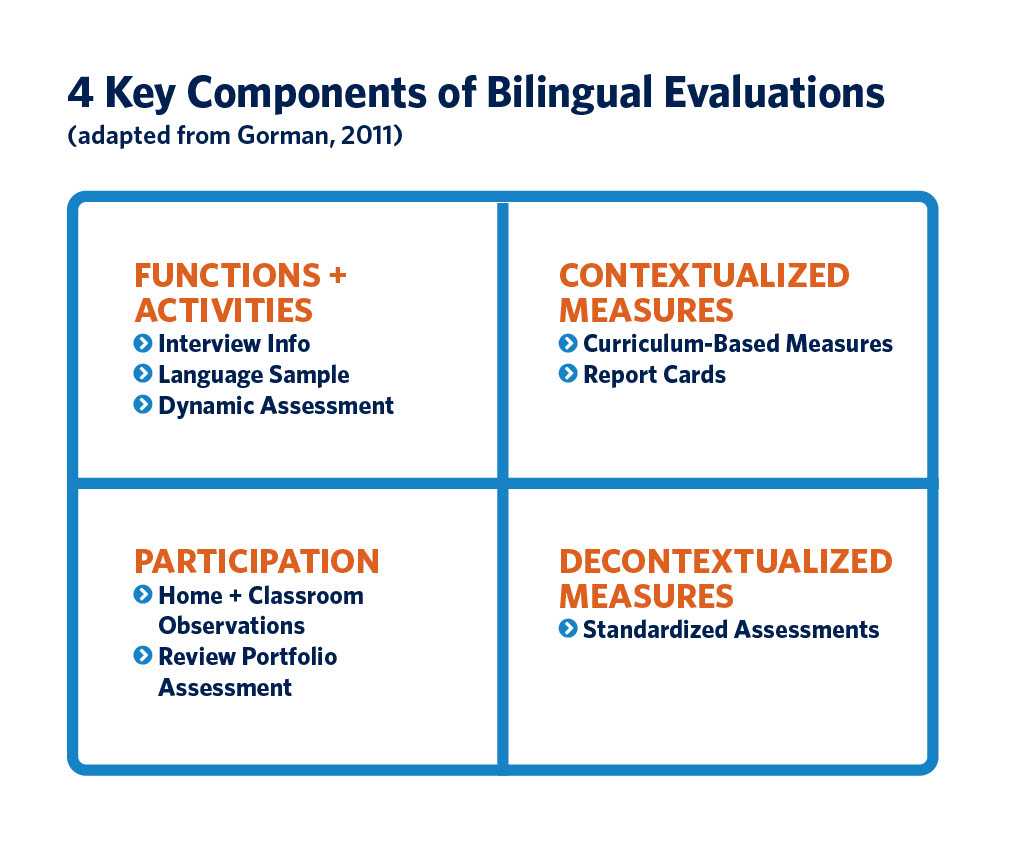Differential Diagnosis
Classrooms nationwide are invested in effectively educating English Learners (ELs), also known as Multilingual Learners (MLs). According to the National Center for Education Statistics (NCES), “In fall 2021, across the 50 states and the District of Columbia, the percentage of public school students who were ELs ranged from 0.8 percent in West Virginia to 20.2 percent in Texas” (NCES, 2024). When MLs struggle with academic demands, educators and specialists—such as psychologists and speech-language pathologists—are tasked with conducting evaluations to determine if academic struggles are due to a learning disability or are part of the typical process of acquiring a second language.
Key Components of Bilingual Assessments
While standardized tests are often viewed as the most important component of an evaluation, some other tools and practices should be used to gain a complete understanding of Multilingual Learners’ strengths and areas of need. Dr. Brenda Gorman explains four key components of bilingual assessments based on Ronald B. Gilliam’s Language Assessment Model. Dr. Gorman emphasizes that the four components should be viewed as equal quadrants of a pie; “not one part is more important than another.” (Gorman, 2011).
 The first component is functions and activities. This includes interviews with parents, teachers, paraeducators, and other professionals who work with the student. Language samples also fall within this component. A language sample analysis provides specific information about a student’s spoken language skills. Another highly regarded approach is to use dynamic assessment (test-teach-retest) to see how well the child can learn with purposeful, directed instruction.
The first component is functions and activities. This includes interviews with parents, teachers, paraeducators, and other professionals who work with the student. Language samples also fall within this component. A language sample analysis provides specific information about a student’s spoken language skills. Another highly regarded approach is to use dynamic assessment (test-teach-retest) to see how well the child can learn with purposeful, directed instruction.
The second component is participation. School observations (and home observations, if possible) provide information about student performance in “real contexts.” Evaluators can also review portfolios – work collected from class assignments and activities – to view performance over time.
The third component is contextualized measures. We can examine how a student is responding to instruction through report cards and Curriculum-Based Measures (CBMs). CBMs are assessments used to monitor progress over time and align with what is being taught in the classroom.
The fourth component is decontextualized measures. This is the area where standardized or formal assessments fall. It is important to note that evaluators should interpret test scores with caution as the test may not be normed on the ML population, may be culturally biased, or may assume a certain level of English proficiency.
To reiterate, these four components (quadrants) are EQUAL parts of a “high quality…assessment used to make a diagnosis” (Gorman, 2011).
Using a multifaceted approach to bilingual assessments that considers a student’s educational and cultural background ensures a complete picture of their strengths and areas of need within the academic setting. In addition, ideally, a student would be assessed in their native language (L1) and English. However, if that is not possible, we need to be strategic in conducting assessments if testing in English is the only option (Pena, 2019). A great way to begin an evaluation of an EL is to conduct a contrastive analysis —a comparison of the English language with their native language in the domains of phonology, morphology, syntax, semantics, and discourse. This allows you to see if particular errors are due to language differences or indicative of a language disorder. Using contrastive analysis is just one piece of the assessment pie.
Throughout my career as a Speech-Language Pathologist (SLP), I have utilized contrastive analysis and Gorman’s framework to conduct thorough, equitable assessments that provide a comprehensive understanding of each student’s language skills. Over the years I have been fortunate to be part of multidisciplinary evaluation teams bringing diverse perspectives and expertise to the evaluation process. This collaborative approach – when paired with the key components outlined above – has been instrumental in ensuring accurate diagnoses and individualized recommendations. In my current role as an educational consultant and coach, I encourage evaluators to consider Gorman’s four key components as a guiding framework for gathering assessment data and supporting accurate, equity-driven evaluations.
References
BiLingusitics. (n.d.). 4 Important Considerations Conducting Bilingual Language Evaluations. Retrieved January 6, 2024 from https://bilinguistics.com/4-important-considerations-conducting-bilingual-language-evaluations/#:~:text=The%20process%20of%20evaluating%20bilingual,the%20structure%20of%20the%20languages.
LingaHealth. (2011, October 5). Speech Pathology: Key Components of Bilingual Language Assessment [Video]. YouTube. https://www.youtube.com/watch?v=Ssz_cutETTE
National Center for Education Statistics. (2024). English Learners in Public Schools. Condition of Education. U.S. Department of Education, Institute of Education Sciences. Retrieved January 6, 2024 from https://nces.ed.gov/programs/coe/indicator/cgf.



